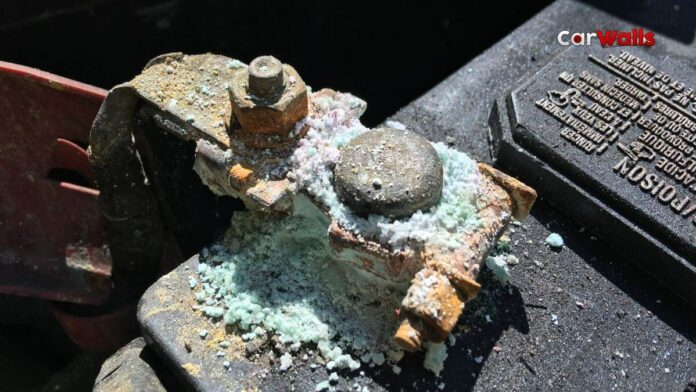Car battery terminals are the unsung heroes of your vehicle. They’re the little guys that do all the hard work, but they’re often overlooked and neglected. But if you want your car battery to last as long as possible, it’s important to keep your terminals clean and corrosion-free.
Here’s a little secret: most people are probably doing it wrong.
In this article, we’ll reveal the secret to cleaning your car battery terminals so that they’re sparkling clean and in tip-top condition. We’ll also give you some tips on how to prevent corrosion from building up in the first place.
So if you want to keep your car battery running strong for years to come, read on!
What Are Some Common Causes of Battery Corrosion?
Battery corrosion can be caused by several factors. Here are some of the most common reasons:
- Hydrogen gas leakage: The battery turns acid into an electric current. Sometimes, the hydrogen gas in the battery leaks and finds its way into the atmosphere. It reacts with other substances, and battery terminal corrosion is the result. Different problems relating to the battery will show up depending on which side of the battery corrosion has formed. If it is on the negative terminal, this is a sign of undercharging. If it is on the positive terminal, it is due to overcharging.
- Electrolyte leakage: This problem is synonymous with lead-acid batteries. Due to age or damage, the battery’s electrolyte can leak and accumulate on the battery terminals. The probability of the electrolyte leaking is increased if you overfill the battery water.
- Chemical reaction in the copper clamps: Copper is a good conductor and does not corrode easily. However, when electric currents pass through the copper terminals, copper sulfate is produced, and this leads to battery terminal corrosion. A bluish precipitate on the copper terminals can signify copper sulfate. Copper sulfate does not conduct electricity well, and you will start experiencing trouble starting your car as a result.
- Overcharging: If your alternator is slightly overcharging your car battery, it might cause corrosion on your car battery terminals. Check your voltage with a multimeter when your car runs to make sure it is not charging over 14.5 volts when you are revving the engine. It can also be because you are frequently charging your car battery too hard with a car battery charger.
- Overfilling the battery: If you overfill your car battery, it might cause the electrolyte to leak out, as mentioned before. Not all car batteries are refillable, but you should absolutely double-check if you have one so it is not overfilled.
Steps For Cleaning Car Battery Terminals
Cleaning your car battery terminals is an important element of vehicle maintenance. Corrosion of the terminals over time might cause electrical difficulties and potentially prevent your automobile from starting. Here are some cleaning methods for automotive battery terminals:
- Safety first: Wear gloves and eye protection before attempting to clean your automobile battery connections. This will shield you from any acid present on the battery.
- Disconnect the battery: You must unplug the battery to clean the terminals. To begin, switch off your vehicle and take the key from the ignition. Then, find the battery and release the negative cable clasp using a tool. Remove the cord from the battery after the clamp has been released. Rep the procedure with the positive cable clamp.
- Clean the terminals: To make a cleaning solution, combine a tablespoon of baking soda and a cup of water. Scrub the terminals and cable ends clean with an old toothbrush dipped in the solution. If the terminals are badly corroded, you may need to remove the corrosion using a wire brush.
- Rinse the terminals: After cleaning the terminals, rinse them with water to eliminate any residual baking soda solution. With a clean towel, dry the terminals.
- Reconnect the battery: Reconnect the positive cable clamp to the positive battery terminal using a wrench and tighten the clamp. Rep the procedure with the negative cable clamp.
- Test the battery: Turn on your car and check if it starts. If not, you may need to jump-start the battery or replace it.
Also Read: How To Charge A Car Battery Without A Charger?
Conclusion
You can maintain your car battery terminals clean and avoid electrical issues by following these easy measures. When working with automobile batteries, always use gloves and eye protection, and if you’re not comfortable doing it yourself, take your car to a professional technician.






